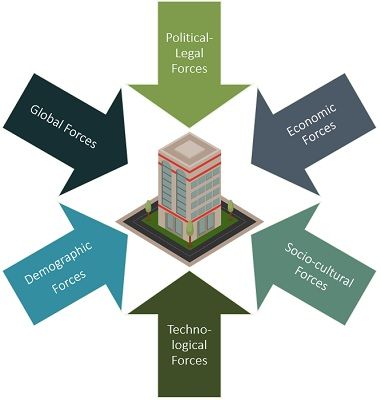Definition: Macro Environment can be described as the collection of those factors and conditions, which has the capability of influencing the business positively or negatively.
Macro Environment is the type of external business environment in which the firm and its micro-environmental forces exist which gives opportunities or pose threats to the firm. It comprises of the elements which are uncontrollable, dynamic and unpredictable.
Elements of Macro Environment
It must be noted that the macro-environmental factors affect the working of every firm operating in the economy because the changes in the conditions are economy-wide and not sector or industry-wide. Come, let’s discuss these elements:
Political-Legal Environment
Political Environment covers the actions of the government, that have a bearing on the company’s operations. Further, the span of implementation of these actions i.e. local level, state-level or national level, is significant in this regard. The top management of the company has to keep a close watch on the actions of the government to take decisions accordingly.
It can be influenced by bureaucracy, tariffs, trade control, corruption level, tax policy, competition regulation and changes in different laws.
Moreover, legal environment covers the laws of the country, the changes in which might affect the functioning of the business, as every organization works within the framework of law and adhere to these laws strictly. These laws may include minimum wage laws, worker safety laws, company law, union law, etc.
Economic Environment
The economic environment encompasses a number of factors such as nature and structure of the economy, availability of resources, level of income, GDP, rate of inflation, degree of economic development, distribution of income, factors of production, economic policies, economic conditions, monetary policy, fiscal policy, licensing policy, etc. which influences the business of a firm.
Further, the lending rates of the bank determines the investment level in any country, such the higher the rate of interest the lower will be the investment made by people.
Socio-Cultural Environment
Society and Culture are an important part of the business environment. It won’t be wrong to say that society shapes the norms beliefs, values, attitude, and principles in the people, in which they are raised.
When we are talking about culture, we are stressing on the dance, drama, music, food, lifestyle and festivals. It also includes arts, law, morals, customs, traditions and habits. Goods and services bought and sold, highly depends on the culture prevalent in the region. Moreover, it also describes the attitude of people towards work.
For instance, there is a boom in the demand for clothes, electronic items, flowers, fruits, sweets, vehicles, etc at the time of festivals or new year. Further, it must be noted that the consumption, lifestyle and dressing style of people vary in different societies and cultures.
Technological Environment
Technology is updating every second and to keep the business going in the long run, the firm has to put efforts to go side by side with the changing technology. How much firm is focusing on innovation and research and development plays a great role in its success, because it can make the firm first and fast mover, in that technology.
The factors included are a type of technology presently in use, technological development level, technology policy, suitable technologies, the rate at which new technologies are adopted and diffused.
Demographic Environment
Demographic Environment covers the type, size and growth rate of population in the area in which the business operates. It discusses the education level, household patterns, age distribution, regional characteristics, level of income, level of consumption of the population.
Here, it must be noted that the marketing mix and the product type the organization introduces, largely depends on the demographic environment. The pricing, distribution and promotional strategies are also based on the demography itself.
Global Environment
After globalization, the companies see the whole world as a market where they can introduce and sell their product and service. However, companies need to adhere to the laws of the countries in which they are operating their businesses, as well as global laws.
Along with that, they need to conduct market research before setting up a company in another country. Further, they have to be familiar with the local language, so as to run the business effectively.
The global environment covers all the factors that have an impact on the businesses operating at the transnational, cross-cultural level and across the border.
The success of a company greatly relies on the fact that how the firm is able to adapt itself and reacts to the changing business environment. The elements of the macro environment strongly influence the strategies and decisions of the firm.
Further, if there are any changes in the macro-environmental conditions, then it may have a far-reaching impact on the company’s business operations, performance and profitability.

Bella says
Who is the author of this article and when was it published?
Surbhi S says
The author of this article is Surbhi S. and it was published on Feb 21, 2020